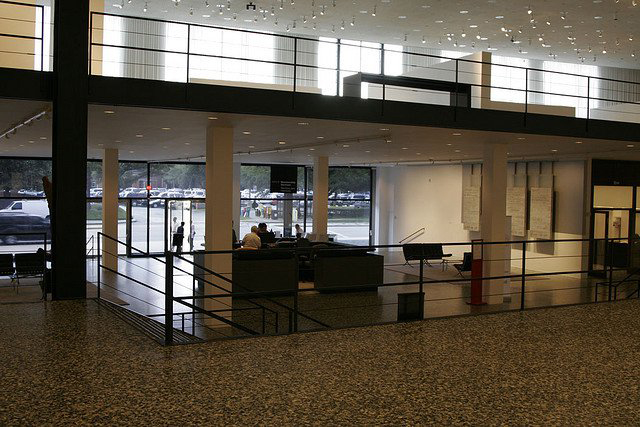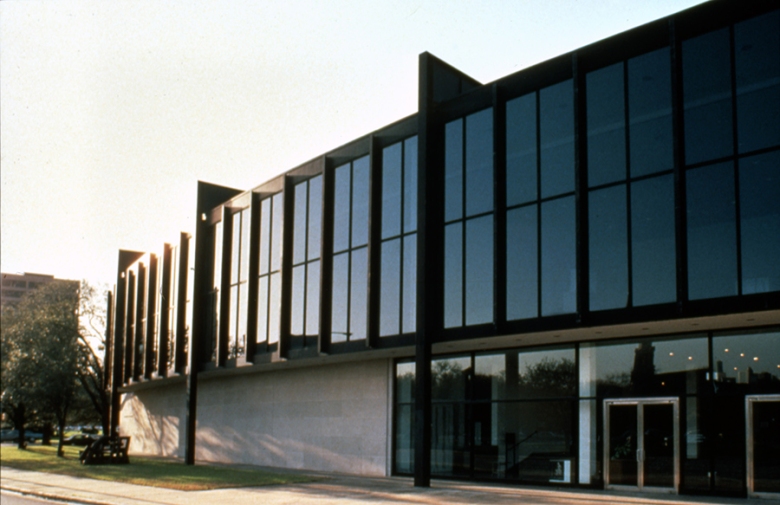
May '15 - May '15

In the early to late 1950’s, German-born architect Ludwig Mies van der Rohe was challenged with the task of designing an expansion for the Museum of Fine Arts in Houston, which would not be only his first of two museums worked on, but also his only one in the United States. This 1920’s neoclassical museum turned modern, which would later need another expansion that would also be carried out by Rohe himself, was a generous gift from that of Nina J. Cullinan, thus the name Cullinan Hall. Rohe, previously famous for his work in both Europe and the northern United States, wanted to create a museum expansion that was very open and inviting. After his initial arrival in the Summer of 1953, the hot, sweaty, yet determined German architect set out to design a pavilion for the museum that was not only non-traditional of museums of his era, but also one that would redefine the qualities of space using his vast experience in design and construction of very tectonic and modern architecture.

Mies van der Rohe’s typical tectonic style is very much so visible in his Cullinan Hall via the way he exposes much of his structure. From the rather lanky exterior columns to the extremely tall and thin imitative load-bearing walls that appear to support the building, Rohe creates a space that is not only large in volume, but also one that is also very public; intentionally designed as a way to captivate people and persuade them to take the journey inside when looked upon from the outside. Rohe, having designed similar works to this in the past, such as Crown Hall in Chicago, and his Farnsworth House in Plano, Illinois, seemingly replicated his largely overdone idea of a stepped entryway into a grand glass ‘box,’ so to say. With that being said, this glass ‘box’ is emphasized even more so than his previous projects with its rather subtle horizontal curve that Rohe creates on the front façade, creating a parabolic-like shape that is perceptionally pleasing and rather bold in nature. Although unconventional of the orthogonally-minded Rohe, this bold move gives the Cullinan Hall a unique atmosphere unlike most other museums of its time. The curve also serves as a the primary interior circulation of the building, radially organized, with both views of Hermann Park in the distance, as well as sets of elongated curved staircases that lead up into a more secluded array of galleries and offices, as well as other alternative entrances. This helped lead to a separation of both public and private spaces, even though its tunnel-like appearance would almost certainly captivate people into exploring the more hidden and private parts of the building, which is what Rohe most likely intended and expected visitors of the museum to do.
Unfortunately for Rohe, a lot of his original ideas and design of the Cullinan Hall would be masked and replaced by new additions to the Museum of Fine Arts in the 1960’s. The organization asked him to expand his not even ten year old museum to make room for more galleries, offices, and a large theater. This new space would eventually be called the Brown Pavillion, in dedication to the foundation in which supported its funding, design, and construction.

Although Rohe would have to cover up much of his previous work at Cullinan Hall, in particular the northeast entrance, he was sure to keep his original idea of a curved front façade by simply pushing it out further and filling up the space within. The design of the newly created space is not too much different in comparison to his original design of the Cullinan Hall, but its primary circulation pathway does have an interesting spatial quality. Rohe utilizes a mezzanine-like structural system with all of its connecting staircases intentionally visible from within it to help promote a clear indication of what the main circulation space is within the building. It also more importantly gave him a chance to further enhance his tectonic style by allowing people to see the different changes of elevation from which they stand on from the side and below, highlighting the steel beams and columns that hold up the rather thin and frail looking floor. The main gallery space of the Brown Pavilion sits on the second floor of the program. It is nearly completely open, with the ceiling being a massive twenty foot plus height, thus giving it hierarchical prominence over the rest of the Pavilion. It is immensely highlighted by the oversized windows, framed in thin steel columns with massive, nearly transparent white curtains shielding the light, that cover the entire upper front façade of the building. These windows and curtains help create a very healthy and natural soft light from the northeast that intensifies the huge volume of the space that surrounds the galleries, largely and quite obviously influenced by both his previous design of the Cullinan Hall, as well as his Crown Hall in Illinois.

The German architect unfortunately did not live to see the end result of his immense work, dying at the age of eighty-three. What he did give us, the city of Houston, was a place that could be enjoyed by many from all walks of life. Rohe’s envision to create a museum full of beautiful tectonic and structural architecture, accomplished by his bold designing, subtle quaintness, and his immense attention to lighting, detail, and space, can be enjoyed by all. The need for expansions to the Museum of Fine Arts in the 1950’s and beyond set in motion for a beautiful modernist museum full of wonderful spatial qualities and fascinating architecture to be designed and built by one of the world’s most prestigious and renowned architects to have ever practiced.
View full entryThis blog is dedicated to the wonderful architecture of Houston, both historical, and present. It will describe general design details of the most influential and monumental works of architecture, as well as their historical backgrounds and precedents.


